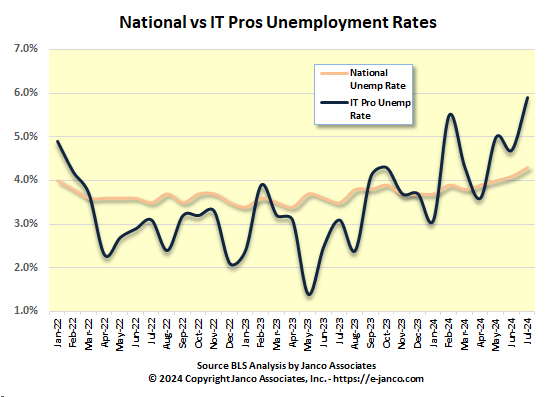IT Productivity Center News and Information
Metrics, Productivity, Salary Survey, Job Descriptions, Business Continuity, ITSM, SOA, White Papers, Compliance, SOX, and HIPAA
The IT Productivity Center feed is an XML news feed that you can subscribe to and re-publish on your web site or blog. The only requirement that you need to meet is that the feed is included with no modifications and that the links within the feed are retained as is.
If you wish to subscribe to this news feed the options that you have are:
Employment picture improves for IT Pros
Tools for CIO, CSO, and CFO can use for Sarbanes Oxley, Disaster Recovery, Security, Job Descriptions, IT Service Management, Change Control, Help Desk, Service Requests, SLAs, and Metrics.
IT Job Market - September 2024
More than 78,000 IT pros were hired in September, cutting into the backlog of unemployed. IT Pros who were unemployed last month found jobs more quickly than was anticipated, as CIOs rushed to fill open positions. Janco predicts the same will happen for the next several months.
The September unemployment rate for IT workers was 3.8%, down from 6% in August. IT unemployment is now below the overall national unemployment rate of 4.1%.
Out of work IT Pros face a difficult jobn market
IT Pros facing a tough job market - takes several month to find a new job
The overall unemployment rate for IT pros in July remained higher than the US national unemployment rate. High unemployment is defined as being 5.5% or greater. The unemployment rate for IT Pros fell slightly from 5.9% to 5.6% but remains greater than the national unemployment rates for the same period.
Work From Home employees depend on at home delivery
WFH & Telecommuting environment vs in-office
The question the WFH employees have is how sure are they that the deliveries they expect are safe. As WFH employees move to the office many are concerned about the threat of porch piracy - the theft of packages left at people's homes. Two solutions to allow for those deliveries to either come to be directed to the employees desk in the office or to another secure site like a local UPS store.
Employees are ordering everything to be shipped to your home has become a reality of American life. At the same time, porch piracy - the theft of packages from people's doorsteps - has also become a reality, and one that is estimated to result in $8 billion of losses a year.
A new global survey from a home-security and smart-home brand, found that 26% of employees are working from home on package-delivery days - just to avoid porch piracy.
Some employment experts believe allowing for personal packages to be delivered at work could be a fringe benefit that would make it easier to get employees back in the office.
As of May 1st over 80,000 IT jobs have been eliminated
4.19 million individuals are employed as IT Pros in the US
As of May 1st, the tech industry has eliminated more than 80,000 jobs for IT Pros, according to industry layoff tracker Layoffs. This in turn is omplicating the green card hiring process that requires first seeking qualified Americans.
The goal of employment-based visas and H-1B work visas is to supplement unavailable skills domestically. But when layoffs are prevalent, the rationale behind these visas becomes questionable.
Employers are required to provide notice to laid-off U.S. workers who are potentially qualified for job opportunities involved in PERM labor certification applications filed within six months of the layoff, under U.S. rules.
The PERM process is often circumvented as employers might prefer to retain H-1B visa holders by transitioning them to green cards, sometimes at the expense of potential U.S. candidates. But trying to work around the requirements to seek a qualified U.S. worker can be perilous for employers.
In 2020, Facebook (Meta) faced a lawsuit from the Justice Department. One such alleged deterrence was a Facebook requirement that U.S. applicants mail their applications. Amazon settled for $4.75 million in civil penalties and up to $9.5 million to eligible victims of alleged discrimination.
2024 Edition of How to Guide for Cloud Processing and Outsourcing
2024 Edition Includes 12 job descriptions and 7 electronic forms
The need to lower cost, increase efficiency and conserve cash has increased the motivation of companies to turn to Cloud Computing and increased the appeal of alternative delivery models. The disruptive shifts in new demand and supply patterns drives changes for how IT services are bought and from whom. Cloud computing requirements need to be well defined.
AI is one of the drivers for enterprises to select both cloud and outsourcing as an option for processing.







